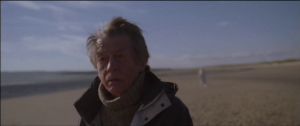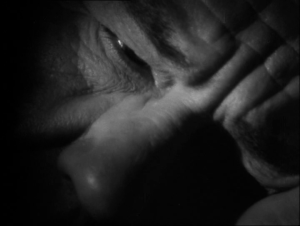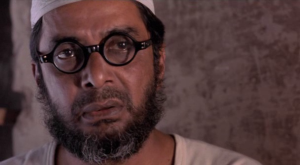Chinese Whispers
This is a follow-up to last week’s post in which I reviewed Jonathan Miller’s memorable screen adaptation of the M.R. James classic short story, Oh Whistle And I’ll Come To You, My Lad. Below is my review of the recent ‘remake’. You may wish to read the previous entry first to get the whole story.
Whistle and I’ll come to you
(2010) Teleplay by Neil Cross Directed by Andy De Emmony

John Hurt stars in ‘Whistle and I’ll come to you’, 2010’s highly-disappointing reinterpretation of Jonathan Miller’s teleplay, reviewed in the previous entry. Hurt himself however is one of the train wreck’s redeeming features.
I think it’s important to begin by saying that the BBC’s efforts to bring the classic ghost stories of M.R. James to the small screen, have, over the years, been a continual source of joy for lovers of old school horror such as myself. While not every adaptation has been as accomplished an approach to film-making as Jonathan Miller’s iconic 1968 retelling of Whistle & I’ll Come To You and Lawrence Gordon-Clarke’s memorable interpretation of A Warning To The Curious, even the comparatively more pedestrian entries have evoked not only the much-anticipated foreboding and supernatural atmosphere of the source material, but a good degree of faithfulness to their underlying themes. Indeed, the BBC proved that this intuitive understanding of this literary fidelity was still very much alive when the classic ‘Ghost Stories For Christmas’ series was revived in the 2000s with the worthy additions, A View From The Hill and Number 13. This, however, cannot be said for 2010’s apparently necessary remake of Whistle And I’ll Come To You, wherein the terms ‘remake’, ‘intuitive understanding’ and ‘source material’ are applied with the same degree of dubiousness as any arguments in support of the production’s validity.
For those unfamiliar, as indeed many still will be after watching the new Whistle, the plot of the original centres around the cocksure academic bachelor Professor Parkins (Parkins in the original text), who takes a vacation during the off-season at a remote Norfolk seaside village for golf and exploration, the latter prompted by a colleague’s request that he inspect the remains of an old Templar preceptory to determine its archaeological worth. This he duly does, and within the crumbling ruins, discovers an ancient whistle, unable to resist putting its practical function to the test. From that moment on, Parkins is never alone, having awoken forces beyond description and quite beyond all human understanding. The heart of the story is the folly of arrogant presumption, that there will always be realms of understanding beyond mortal man, and to believe you can quantify existence is to invite downfall. James’s overconfident scholar and protagonist is the perfect vehicle to deliver this message, and an archetype that the writer, who was himself a highly-accomplished academic, knew better than most. The rapid destruction of Parkins’s self-assured, almost autistic world is almost as disconcerting as the unknown forces he has unleashed, for which we are given only fleeting glimpses and very little explanation.

Gemma Jones as Alice Parkin, whose presence greatly humanises the main character, thereby entirely undermining his raison d’etre.
All of which clearly flew over the heads of the 2010 production team, who presumably felt that the core elements of the story were its beach setting, the university professor more inclined to the rational than the superstitious, and the general bleakness of his existence. So long as some vague continuity with these components was maintained, it seemed perfectly reasonable to completely rewrite both story and characterization to the point where the result was a vague shadow of its former self yet could still be legitimately broadcast under the same title.
The Neil Cross teleplay, in which the action is relocated to the present day, sees a Professor James Parkin committing his wife, apparently suffering from advanced senile dementia, to a care home before taking a long overdue vacation on the Kentish Coast in order to come to terms with his loss. The seaside resort also happens to be their one-time honeymoon destination, and the discovery of a ring in the sand dunes brings to life more than mere memories for Parkin. Something seems keen to communicate with him on the deserted coast, and it may not be as unfamiliar as it first appears.
Cross’s script quite spectacularly fails to grasp the point of the James tale, retaining only superficial vestiges of its substance. Gone is the arrogant, antisocial university mandarin of the original. In his place is the more socially-capable doting husband whose rational worldview is in no way extreme and borne of great personal tragedy – again entirely caused by the most intimate of social interaction (the original Parkins wouldn’t even know what to do with a woman). The character’s ultimate fate is seemingly more extreme, yet far more simplistic and obvious, undercutting the psychological ramifications of his plight.
“Cross’s script quite spectacularly fails to miss the point of the James tale, retaining only superficial vestiges of its substance.”
The ‘ghost’ of the story is equally less subtle and, by the climax of the tale, extremely more quantifiable than its antecedent, of which one understands no more by the end than they did when it first appears. Its intangible mystery is precisely the point of its existence, being something so alien that not even the well-read professor can define it.
The whole dramatisation is, in short, comprehensively dumbed down. The rapid departure from the original narrative is, according to those behind the camera, because Jonathan Miller had already dramatised the story so well that there seemed little point in retreading the same ground. The truncated title, the fact that the character is named Parkin and more significantly, that he is middle-aged, are further clear signs that it is the 1968 Omnibus adaptation rather than the book from which inspiration was drawn. The reigns are firmly in the grip of Marshall McLuhan’s prophesied generation wherein the televisual medium has become the message for those who work in the industry. Television is its own reference point and must now be the source material for rehashing plots with diminishing returns. Heaven forfend that the book be the wellspring of inspiration instead. Telling the same story is surely the point, and the fundamental element of a remake. Artistic vision and execution are surely the obvious ways in which it can be taken in new directions. And if there is little point in retreading ground well-covered in the past, this, surely, is proof that the exercise was unnecessary in the first place.

Kingshead and Botany Beach on the Kentish coast provide some excellent backdrops. Certainly the casting and production values are not at fault here.
Cashing in on a popular title is perhaps the greatest offence and indeed irony, since the Cross script under the direction of Andy De Emmony does deliver its own chilling moments. Add to this the very capable cast headed by John Hurt and Gemma Jones and some excellent location shoots, and there is much to otherwise praise. More damage is done to it by being arrogant enough to masquerade it as something it is not, whereas a more favourable analysis would be quite easy if it were touted as a new work in its own right. It isn’t, however, being instead an unwarranted ‘Disneyfication’ of a far darker psychological piece that a new audience will mistakenly equate with Britain’s greatest master of the macabre. It is the same blind egotistical behaviour that Hollywood is typically blamed for. With them, however, such silliness is expected.
*****
.
Next Time
As indicated last week, World On Film will be going all Nollywood for the Benin-themed film, Abeni. I’ve even found a trailer, which you can see here. No subtitles, but you’ll get the general idea.
The Summoning
World On Film takes a side-step this week as its author, in the grips of the festive season, festively gets to grips with an old Christmas tradition.
Some years ago, when I was abandoning the bloated, overpriced and utterly tedious corpse that Christmas had then become and keeping only the core elements that made sense to me (decent food, wine, the company of people genuinely close and a few laughs), I realised one key element of traditional Northern European yuletide festivities was missing: ghost stories. Enjoyable horror, as opposed to the dreaded misery of the Eastenders Christmas Day special, the terrifying wit of Graham Norton and the bone-chilling inevitability of a youthful Aled Jones. Thankfully, the BBC have over the years seen fit to adapt the work of yesteryear’s masters of the macabre, such as J.S LeFanu (Shalken The Painter), Charles Dickens (The Signalman) and many dark outings from the greatest British scribe of the Victorian ghost story of them all, M.R. James.
Indeed, 2010 was the year one of his most popular tales would be remade for a modern audience, but before it is held up to scrutiny, World On Film explores the still-powerful original, that being:
Whistle And I’ll Come To You
(1968) Written by M.R. James Teleplay & Direction by Jonathan Miller
“There are more things in heaven and earth than are dreamt of in philosophy.”
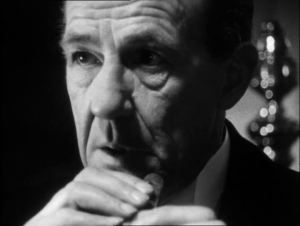
'Who is this that is coming?' Michael Hordern summons the unknown in the classic M.R James tale, 'Whistle And I'll Come To You'.
(To see a brief clip, look to the bottom of last week’s post.)
A university professor, arrogantly believing he holds all the answers to life, the universe and everything, faces the ultimate horror during a vacation at a quiet coastal village in Norfolk when he encounters something that goes beyond all rational explanation.
It was a rather bleak and overcast afternoon several years ago when I happened to catch Whistle And I’ll Come To You, Jonathan Miller’s excellent adaptation of Montague Rhodes James’s signature ghost story. The iconic tale was my first visit to the Jamesian world of understated Victorian horror – a world he seemed to inhabit effortlessly – and I would as quickly as possible go on to devour every other work that I could get my hands upon. Although Whistle is a very different beast in many ways to the original short story upon which it is based, Miller expertly brings the essential underpinnings of the tale to life with a balance of modification where perhaps budget intervened, and fairly instinctive faithfulness. Filmed some 50 years after it was written, it is almost that long again since and the monochrome retelling still has the power to delight and scare.
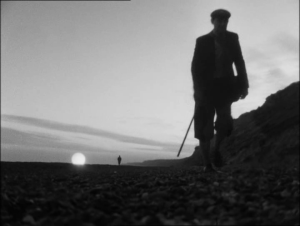
The quiet build-up of menace and terror, almost unnoticed at first, quickly became the James trademark, now standard practice in old school horror.
Miller seems to grasp the author’s restrained and quiet approach to drama effortlessly. James belonged, and very comfortably inhabited, the old school of literary horror. It is a discipline largely of the implied, of the vaguely-suggested, an enormous sepulchrally-lit room wherein the rational must fight to be heard and, finding no familiar ground, is often mercilessly subdued by that which it cannot define. It is the world of the oblique and the unseen, save for a few terrifying half-interpreted glimpses into a forbidden dimension of chaos, the dark denizens of which will inflict upon the ordinary man only terror and madness should he gaze upon them too closely, or worse still, attempt to make sense of them. Even the most intact survivor is forever changed and robbed of all previous convictions. It is, in essence, a horror that derives from what is unseen save for a few tantalising details that will unseat the ego carefully crafted to cope with the everyday world and shatter the anthropomorphic world view. While Dickens did not attempt, like James, to glimpse at the Hadean talons behind the shadows, he nonetheless understood the fundamental mechanisms of the genre: The Signalman is a celebration of the power of description set within maintained unease. Much of the drama is down to the buildup of suspense and atmosphere, with the audience left largely to draw their own conclusions in the theatre of the mind, save for one or two terrifying, yet tantalizing and well-timed glimpses into the abyss provided by the writer. Lovecraft, the successor to both authors, carried on the tradition of reluctant descriptive prose for the purposes of implication, where the full revelation opens the curtains with unsubtle recklessness, calls in the daylight and the mood is forever destroyed.
“[Director Jonathan] Miller expertly brings the essential underpinnings of the tale to life with a balance of modification where perhaps budget intervened, and fairly instinctive faithfulness.”
This approach, now the benchmark of the proper ghost story, is precisely what we get in the teleplay, shot on location in Norfolk, where the scenery and incidental sounds do much of the work. This is especially important given that the overconfident lead character, who almost entirely inhabits a world of his own creation and does not engage in a great deal of dialogue. The less-is-more approach is wonderfully effective: much of the tension comes from nightmarish dreamscapes and strange objects ominously kept in the distance, and the lack of continuing verbal commentary allows for wonder and suspense to build to great effect. And indeed the true horror is psychological: that which cannot be qualified, a true terror to one who thinks they have reality fully understood, and poignantly, one they have brought entirely upon themselves. The monochromatic nature of the film lends to the bleak and cold surroundings of the Norfolk coastline, although as viewers were to find in the BBC’s next James adaptation, A Warning To The Curious, full colour is by no means more comforting.
Headlining the cast, the late and legendary Michael Hordern is a good deal older than the Professor Parkins of the text (Parkin in the film), which unfortunately loses the idea of arrogance in one so young, but Hordern is such perfect casting and fits the character so well that one can more or less forgive the character’s transformation. The other principal lead of the Colonel, played with great understatement by Ambrose Coghill, also finds his part reduced in the teleplay, although his conversational foreshadowing, in which he suggests that the realm of knowledge may be greater than Parkin smugly allows for, is crucially intact. Indeed, Miller’s assured hand preserves the essentials of the storyline and ensures that things move at a consistent pace, realising the ambiguous supernatural elements with skill to a satisfying conclusion.
Any fan of classic horror would be doing themselves a disservice to pass on this marvellous visual retelling of one of M.R James’s most celebrated ghost stories. Even now, as a new version is about to hit the small screen, I will be very impressed indeed if it manages to surpass the wonderful and original monochrome masterpiece.
*****
The Creature That Came In Answer
The following section is a comparison of the film and the original short story. Please do not read this section if you haven’t seen/read either and don’t wish to be spoiled. Scroll down to Further Reading below therefore to avoid any major revelations.

Miller takes great care to capture the enormous distance between the self-contained Professor Parkin and everyone around him.
Jonathan Miller’s monochromatic adaptation of ‘Oh Whistle, And I’ll Come To You, My Lad’ was the first time the story had made it to the small screen. That very same year however saw Robert Eddison (probably best known today for his portrayal of the Grail Knight in Indiana Jones & The Last Crusade) star in the fourth James adaptation for the highly-successful ITV anthology series Mystery & Imagination, ‘Casting The Runes’. Whistle was also part of an anthology series, though unusually, it was the BBC’s long-running Omnibus program, primarily known for its documentaries on a variety of subjects.
Those familiar with the original short story may consider Miller’s efforts to be a somewhat truncated version of the tale, with character motivations removed and certain key scenes omitted from the film. Even the title (a line from a Robert Burns poem) has been shortened, as if symbolic of Miller’s desire to distill the story down to its core potency. It is a Professor Parkin, not Parkins, who comes to the remote Norfolk seaside village for recreation. He is middle-aged rather than young, and is entirely disinterested in golf, while for his literary counterpart, the sport forms fully half of his reason for choosing the venue. Golf appears frequently in James’s short stories as the sport du jour of the upper-middle class academic, though he is often dismissive of it, as in ‘The Mezzotint’, where it is enough to mention the fact that the main characters spend an afternoon on the green, “but [the details of] which the conscientious writer has no right to inflict upon any non-golfing persons.” Ironically, a significant golfing scene occurs in ‘Oh Whistle, And I’ll Come To You, My Lad’ between Parkins and the Colonel, who becomes annoyed at the young professor’s prowess. The sport becomes the common ground for their growing relationship and when not searching the sands for a Templar preceptory, they often found in each other’s company. By their second golfing game, “they got on so well together in the morning that there was no talk on either side of their separating after lunch.” On television however, they merely know each other through mealtime conversations and from this principally is their relationship developed.
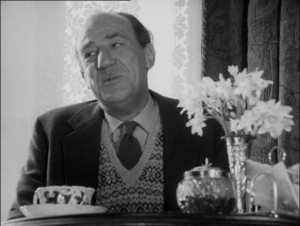
Though significantly older than the Parkins of the text, Michael Hordern expertly captures the cocksure nature of the lead character, assured that the world is easily quantifiable.
Of course the Templar preceptory, a crumbling ruin largely buried beneath the sand on the shores of the beach, becomes instead a more modern Christian cemetery upon the embankment high above the beach. Doubtless Miller would have been only too happy to have showcased the former if an obliging Norfolk beach had presented itself (filming in Lincolnshire might have yielded results), though the ridiculous ease with which Parkin finds his whistle is entirely faithful to the equal good fortune Parkins has within the sand. The absence of the preceptory also robs Parkin of another of his ambitions while in the area. In the short story, it is a fellow colleague who asks him to check the ancient ruins to see if “it would be any good to have a dig there in the summer.” On television, it is Parkin who plans his visit to the cemetery, simply to indulge his own curiosity.
“Those familiar with the original short story may consider Miller’s efforts to be a somewhat truncated version of the tale.”
The ghost of the story is largely the same in both versions. In the climax to the short story, it is “a horrible, an intensely horrible, face of crumpled linen” (sic), as if framing the face of the invisible monster within. As with the not readily available Templar artifacts, Miller does not quite have the technology to reproduce such a visage, which the prose so successfully invokes in the theatre of the mind. One final noteworthy absence is the earlier scene involving a small boy terrified out of his wits upon seeing a white sheet rise up to the window of Parkins’s room seemingly animated by nothing of the material world. The youngster, half-crazed, relates the vision to the room’s occupant, foreshadowing the nightmare he will soon experience for himself. Given that it is a related tale rather than in real-time, Miller perhaps has decided that it would undercut the ghastly revelation of the haunted bed sheet.
Here then we return to the idea of distillation, for despite the many trims made for the screen adaptation, there is no doubt whatsoever that Miller has understood the heart of the tale. While not “young, neat, and precise in speech”, his Professor Parkin is no less arrogant and cocksure, more than content to the point of preference to inhabit a world populated exclusively by himself, with human company welcome only either for the purposes of showing off. Company becomes more desirous when this world is thrown into disequilibrium. Parkin is less “precise” in his speech however, often so caught up in his perpetual interior discourse that words are frequently fumbled and sentences disjointed. Parkin’s disinterest in golf, the one opportunity Parkins of the text has to maintain social interaction, makes the elder character of the film even more isolated and withdrawn.
The decision to make Parkin older may have come down entirely to the casting of Michael Hordern, who captures the haughty academic perfectly. Hordern gives Parkin a delighted self-assurance that his world view defines the very building blocks of the universe, only later to quickly unravel when the paranormal sends him into meltdown. He engages in frequent muttered dialogue with himself, chuckles happily at his genius, and generally glides through life seemingly unaware of it. At the climax, Hordern wonderfully plays Parkin’s abject horror at the indescribable, the inexplicable reality that nearly destroys him, and unlike the text, this is also the point at which the credits roll, giving no hint of how successfully he will recover, if it all.
“Michael Hordern captures the haughty academic perfectly… giving Parkin a delighted self-assurance that his world view defines the very building blocks of the universe, only later to quickly unravel when the paranormal sends him into meltdown.”

The bleak but powerful Norfolk coast provides some excellent locations, helping to lend faithfulness and authenticity to the adaptation. Does anyone know where this groyne is exactly?
Similarly, although absent of any Crusading knights’ stronghold, the filming locations are otherwise very authentic and faithful to the original. The lonely Norfolk coast is every bit as isolated as the text describes it: “On the south you saw the village of Burnstow. On the north no houses were to be seen, but only the beach and the low cliff backing it.” Indeed, only the guest house appears on screen as proof civilisation’s existence, making sandy shores even more remote. The interior of the brightly-lit residence is a sombre space, where sound is an exception rather than the rule. Indeed silence plays a huge part of the production, with Miller keen to emphasise not only the great isolation of the world Parkin has stepped into, but the tremendous distances between himself and the rest of humanity. The monochromatic nature of the film only serves to emphasise the gloom.
Technological limitations aside, the apparition of the story is recreated more or less as one would expect it to appear. More importantly, the slow build-up wherein the ghost’s presence is felt more than seen except occasionally in the distance, is entirely faithful and effective. The dream sequences are very carefully actualised so as to appear as they did in prose, even down to the fact that no matter how often Parkin opens his eyes, the nightmare instantly returns when he closes them again; while the odd pulsing sound effects expertly build up the tension of pursuit and menace, with the beach groyne described in the text shot from below to good effect. In all the places where it matters, Miller has remained as faithful to the original as his 1968 budget and technical capabilities have allowed him to be. Coming in at approximately 41 minutes, the adaptation is just long enough to build up the slow, but steady pace of the source material without being too long so as to lose momentum.
Christmas Eve 2010 saw this most celebrated of Jamesian ghost stories return to the small screen. It too bore the name Whistle And I’ll Come To You and starred John Hurt in the lead role – both suggesting that it may owe more allegiance to its television predecessor than the short story itself. That however, is for another time.
*****
Further Reading
The short stories of M.R. James are now out of copyright. Subsequently, you can read ‘Oh Whistle, And I’ll Come To You, My Lad’ right here for free. ‘The Mezzotint’, also mentioned above, can be read here.
*****
The End of the Beginning
And with that, we come to the final entry for 2010. There will be no ‘proper’ update next week while I, and very likely the rest of you, ring in the new year. However, I may write a follow-up to this post praising or lamenting the remake of Whistle.
Otherwise, World On Film returns in early January to continue the ongoing mission. Coming up: childhood sweethearts reunited, but their parents have other ideas for their marital futures. Love and melodrama in Benin as we explore the Nollywood flick, Abeni.
Breakdown
Welcome. Let’s jump straight into things this week with the entry for Bangladesh:
The Clay Bird
(2002) Directed by Tareque Masud
“The bird’s trapped in the body’s cage. Its feet bound by worldly chains, it tries to fly, but fails.”
‘The Clay Bird’ opens a door into Bangladesh’s fight for independence in the late 1960s when the soon-to-be nation state was a far-flung region of Pakistan, following the partitioning of India in 1947. Increasingly disenchanted with the distant central government due to racial, cultural and economic discrimination, Bangladeshis began taking to the streets in protest, demanding a general election as the springboard for autonomous rule. The election was cancelled and the Pakistani military were sent in to quell the uprising, murdering thousands and destroying population centres. A civil war ensued, eventually leading to independence in 1971. The film is set just prior to the prolonged and bloody uprising, as citizens find themselves galvanized along religious and political lines, with tempers beginning to fray. Rather than depict events at the heart of the capital, the story centres around the lives of a rural family in a remote village, bearing witness to the way in which the winds of change blew across the ordinary citizen. While the intent of this is sound, the end result is something of a mixed bag.
The plight of the family proves an effective allegory for the various Bangladeshi attitudes to the turmoil their world is in. Kazi, the father, a born-again Muslim, reflects the ultra-conservative stand that faith and discipline will unite the people under Allah, and is unable or unwilling to accept that the deeply fractured society around him faces problems that cannot be solved through prayer. Milon, his brother, a young political extremist, stands ready to fight for the nation with the unwavering confidence of the just. Ayesha, Kazi’s apolitical wife meanwhile, is interested simply in getting through the ordinary day to day struggles of life. Asma, the daughter, is too young to be constrained by the petty concerns of adults, while Anu, the young son, is propelled unwillingly by conflicting forces and ideologies he doesn’t understand. It is the nation in miniature, about to burst at the seams.
“[The family] is the nation in miniature, about to burst at the seams.”
Yet there is a somewhat meandering quality to the pacing, perhaps in part because the writer has not entirely decided upon the story he wants to tell. It could very easily simply be the story of a young boy forced to attend a madrasa (Islamic boarding school) by a father terrified his son’s mind will be polluted by non-Islamic ideas and therein be a commentary on Islamic extremism itself. Indeed, a large chunk of the film is just that: there is a very telling scene where the young Anu and his uncle watch a Hindu boat race, clearly enjoying themselves, only to be reprimanded for celebrating diversity. Kazi’s religious fervour has him at odds with the rest of his family, incapable of being the father and husband they so desperately need. The dogma strangles the family to the point of dysfunction. Equally telling is the character of Milon, whose more secular and open-minded world view is the foundation for the forthcoming nation-state. Religious dogma is equated with denial, while the activist is the realist.
Fortunately, the Islamic discourse eventually digs deeper and there is a nice scene where two of the madrasa teachers make the point that the religion spread so successfully across Bangladesh precisely because it was a peaceful ideology. Whatever one’s beliefs, there can be no denying that this sort of discourse on Islam is rarely found outside of Islamic countries. The very idea that it must be spread by force and violence is just such a question pondered with dismay by one teacher struggling to understand how religion became part of the rising civil war in the first place. That the Muslim extremists involved in acts of terrorism rivaling the invading Pakistani army might be missing the point is one of the many tragedies of that war, though it is important to remember that many factors came into play, not least cultural and economic destitution. However, director Tarique Masud does not adequately explore these factors, which if the aim is to give a snapshot of society during that time is quite remiss, suggesting that he is more interested on religious commentary. Yet the film goes beyond the madrasa, so that those set up as the main characters then disappear for long stretches like the inhabitants of a Tolkien novel. This unravels the sequences designed to build up character storylines, with the disjointed result leading to the uneven pacing. This leaves the conflicts faced by some to be either insufficiently built up or not satisfyingly followed through. Masud ultimately needed to choose one storyline and stay with it.
“There is a somewhat meandering quality to the pacing, perhaps in part because the writer has not entirely decided upon the story he wants to tell.”
Nonetheless, the cast perform with the conviction and skill necessary to draw the viewer into their characters’ worlds – when we are able. However, standouts for me include Russell Farazi as Rokon, Anu’s one true friend at the madrasa – a likeable, yet misunderstood loner, and the young Farazi is more than able to imbue the character with the complexities that reside in such a part. Soaeb Islam, meanwhile, brings to the wannabe revolutionary a warmth often without any dialogue whatsoever. Clearly, Kazi is set up to be a stiff-necked Islamic convert, giving Jayanto Chattopadhyay not a lot of range, however, this does allow for a meaningful scene at the end where the horrors of war force Kazi to face his religious convictions. And while Nurul Islam Bablu is no Marina Golhabari, he gives Anu the profound innocence that the script requires of the character.
Ultimately, ‘The Clay Bird’ is not quite the tale of Bengali struggle it purports to be, due to unfortunate scripting and editing choices that take much of the wind out of its sails as a result. However, it opened up a window into a history with which I was hitherto unfamiliar, with many thought-provoking and sometimes touching sequences that still manage to shine through – even if the sum of the parts is conspicuous by its absence.
*****
The Memoirs Of A Self-Confessed Surrealist
(1978) Directed by Alan Yentob
“The marvellous is beautiful. Anything marvellous is beautiful. In fact, only the marvellous is beautiful.”
In 1978, jazz player, film critic, writer and lover of melting watches, George Melly, undertook a journey from his Notting Hill home to visit the Great Exhibition of Dada & Surrealist Art at the Hayward Gallery near the Thames. Along the way, he relates his long and passionate love affair of the surrealist movement and its many colourful denizens, reliving many experience of his own both surreal in encounter and Dadaesque by design.
Melly recounts how he joined the British surrealist movement after serving in the Royal Navy during World War II after discovering the book Surrealism by Herbert Reed, the paintings within revealing “a world I’d always suspected had existed, but which I didn’t know how to get into.” To him, surrealism “is the spirit of the dream, coupled with reality” – a world based firmly upon reality, but overlaid with the heightened states of imagination contributed by the participant. This is an important distinction from fantasy, where the impossible has been divorced from the everyday and celebrated. Surrealism is firmly grounded in the ordinary, but through the freedom of imagination is able to perceive it as the marvellous. Even Salvador Dali had to be an impressionist before he could depict the inner world within. The surrealists embraced convention, recognising that they could be easily dismissed if they fitted the stereotype of the artist. Those like Magritte, who were far too busy challenging perceptual reality to bother with extravagance, were more successful with this aim, while for Dali, extravagance was the point.
“Oh, Dali. What a genius you were, and what a sad clown you have become.”
‘To [Melly], surrealism “is the spirit of the dream, coupled with reality.”’
The surrealist world according to Melly is a close-knit community, a movement shared in full agreement by his members. This is perhaps unsurprising, given that Melly knew most of its primary practitioners personally, his own surreal poetry entering the canon of which notable entries lament the loss of a friend.
“When Magritte died, the stones fell to the ground, the birds divorced their leaves, the breasts became blind, the tubas extinguished their flames, the pipe remembered its role, the words looked up what they meant in the dictionary, the ham closed its eye forever, when Magritte died.” – Excerpt from “Homage to Rene Magritte”, by George Melly
Likewise, he is able to name check the likes of Marcel Duchamp, Man Ray, ELT Mesens, Giorgio de Chirico and Max Ernst with anecdotal clarity. The poetry of Dadaist Kurt Schwitters once saved his life in a dark alley, while the simple, yet revolutionary words of Andre Breton in a conversation decades earlier helped him expect the unexpected from the ordinary. Weekly gatherings at the Barcelona Restaurant in Soho brought him into contact with violin-torturer Robert Melville, pacifist air-raid warden Roland Penrose, suspected Fifth Columnist Conroy Maddox, and anarchist bus conductor Arthur Moyes among others. Inheritors to the surrealist oeuvre are introduced, notably Monty Python, painter Patrick Hughes, blue novelist and fashion guru Molly Parkin, and British rock band The Stranglers, although surely The Stranglers were Dadaists, since as Melly says himself in description of the movement, “the beginnings of Dada were not art, but disgust.”
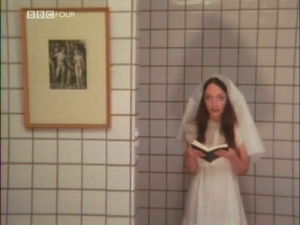
Visitors to a famous Max Ernst exhibition entered through a bathroom in which a teenage girl read dirty poetry.
The long journey includes, as one might expect, plenty of visual examples of the Dada revolt and the Surrealist reinterpretation, from the paintings that still inspire wonder in the minds of many today to the buildings that were created as a result. When not heard to ‘ursonate’, Melly’s poetry parts the clouds of conventional thinking and forces all ears to see the world in-between. It is, after all, a personal journey, and for fans of the genre, a quick and entertaining celebration of everything that makes the movements so exciting and fires the flames of marvellous creativity. For the novice, it serves as an entertaining introduction to the surrealist and Dadaist movements, the key works of both, and the artists who created them. As to availability, BBC4 occasionally repeats it along with other Arena classics, otherwise look online in the usual places.
*****
Next Time
Life, death, love and anguish, as the lives of 14 Belorussian businessmen take centre-stage in the documentary Brigade, or A Toast To A Clean Friday, part of Rutger Hauer’s I’ve Seen Films short film festival.

